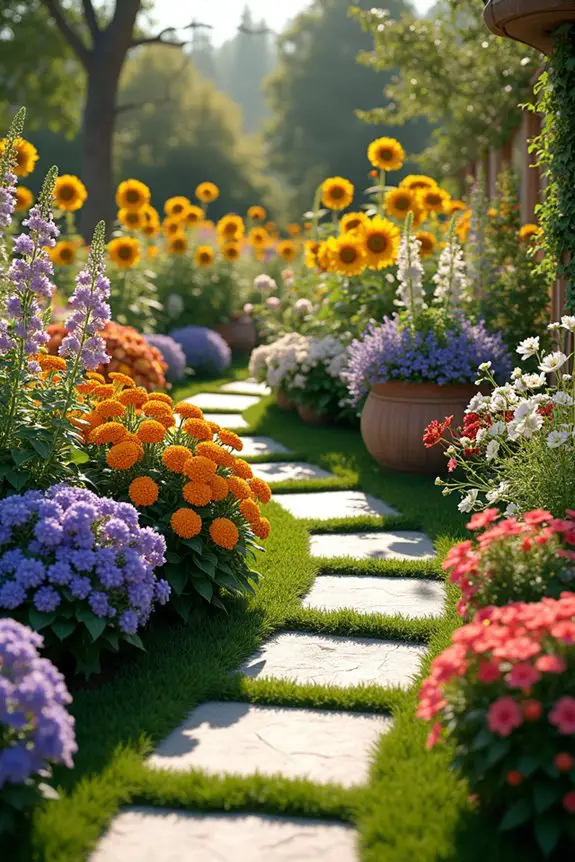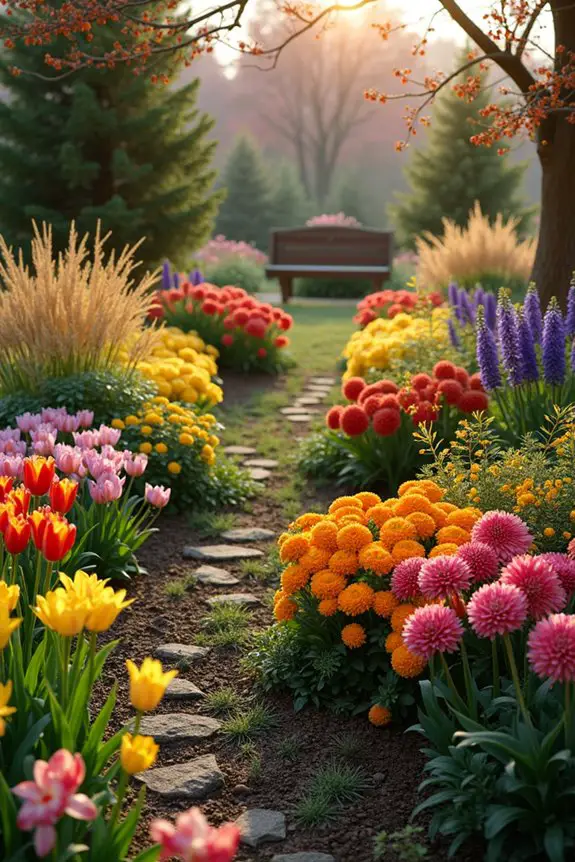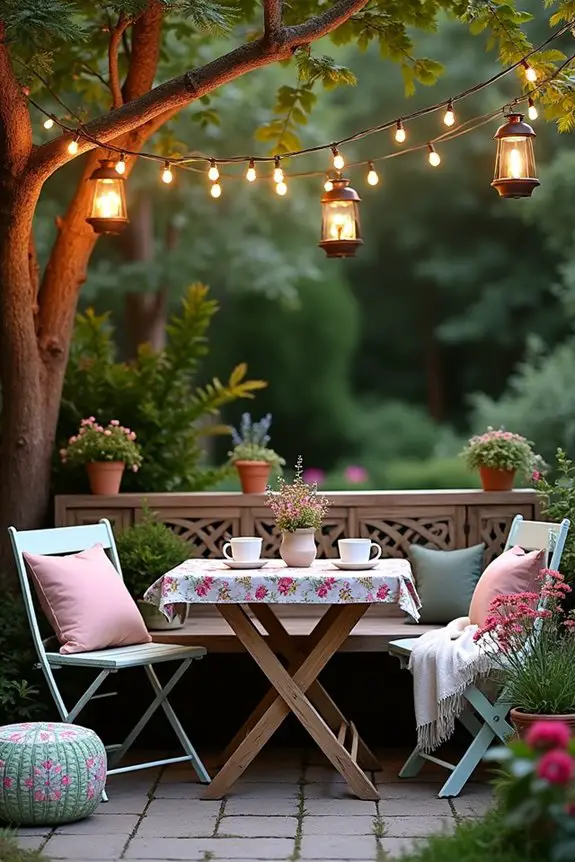Got a Bloxburg garden that’s lacking pizzazz? Let’s chat about how to transform that space into a vibrant outdoor oasis. Picture lush flower beds bursting with color, meandering pathways leading you through, and maybe even a whimsical water feature. Sounds dreamy, right? But where do you start? From picking the right plants to setting up charming layouts, there are plenty of ideas to explore. Stick around; you might just find the perfect touch for your garden.
The Floral Arrangements
When it comes to floral arrangements, you’ve got tons of options to make your garden pop.
Think about a colorful flower bed layout that catches the eye, along with a garden pathway design that’ll lead guests on a delightful journey.
And hey, don’t forget to sprinkle in some water features and vertical gardens for that extra wow factor—trust me, your garden will thank you.
1. Colorful Flower Bed Layout
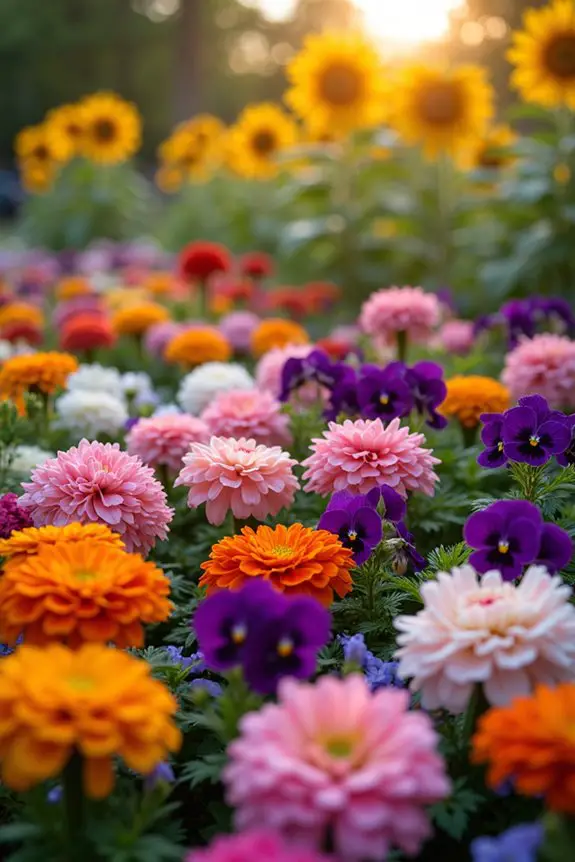
When it comes to creating a colorful flower bed layout, think of it as painting a canvas. The vibrant splashes of reds, yellows, and purples not only brighten up your yard but draw in butterflies and bees too. Imagine how cheerful it’ll be to step out and see a burst of color each morning.
To get started, choose a variety of flowers that bloom in different seasons. That way, your garden stays lively all year long. Reflect on mixing perennials like daylilies and peonies with annuals such as marigolds and petunias. It’s like a surprise party every season.
Also, don’t forget to take into account the heights of the plants. Taller flowers like sunflowers can stand proudly in the back, while shorter ones, like pansies or violets, can fill in the front. This way, every flower gets its moment in the sun, literally.
And, of course, the layout itself is essential. Picture a zig-zag or wave pattern; it adds flow and movement to the design. I once tried planting in straight lines, and it turned out to be as exciting as watching paint dry (not great, right?).
Instead, I played around with shapes and sizes, creating clusters of similar colors. Suddenly, my garden transformed into an eye-catching spectacle.
You can even add some contrast, playing with both warm and cool tones. Pair bright oranges with calming blues or soft pastels with bold reds. It’s like cooking—mixing flavors for the perfect dish!
Just remember to step back often and admire your handiwork. You might find a spot that needs a little extra flair—maybe a pop of pink or a dash of purple. Just like cooking, gardening is all about tasting and tweaking. There’s no wrong way to create beauty!
2. Garden Pathway Design
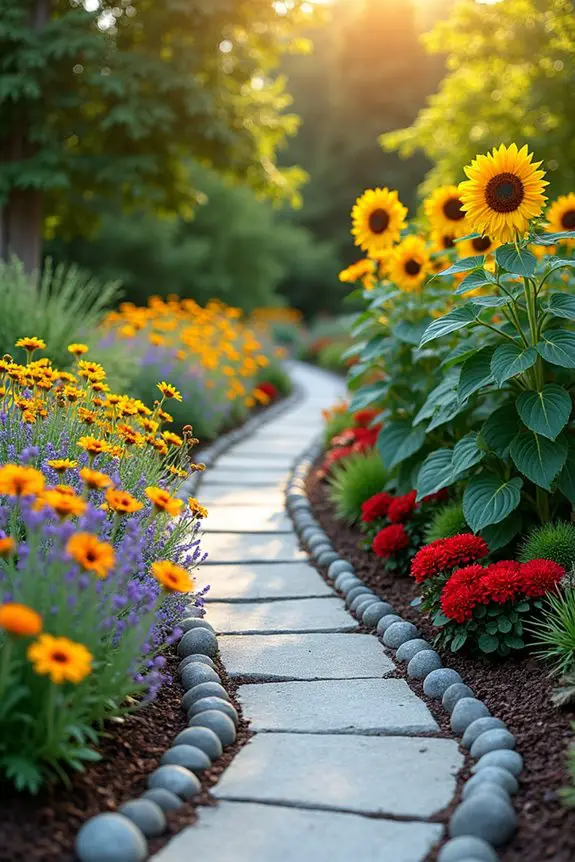
When designing a garden pathway, incorporating floral arrangements along the sides can create not only a beautiful visual effect but also a welcoming vibe. Imagine stepping into your yard and being greeted by a lush display of flowers. It’s like an invitation to wander—if your pathways could speak, they’d be calling you to explore.
First things first, let’s think about layout. A winding path adds a sense of adventure while straight paths can give a clean, organized look. Either way, lining your pathway with flowers will enhance the experience. I once planted a row of charming daisies on one side and soft lavender on the other, and let me tell you, walking down that path felt like strolling through a flower shop. Each time I stepped outside, it brought a smile to my face.
Now, about those floral arrangements—layering is key! Taller plants should go closer to the back or further away from the path, allowing shorter blooms to bask in the sun right at eye level. Just the other day, I made the classic mistake of putting my sunflowers at the front. Talk about blocking my view!
Speaking of layers, consider mixing textures too; big leafy plants can contrast wonderfully with delicate flowers. Think about it like making a salad. Some crunchy greens paired with juicy tomatoes? Yes, please!
Don’t be shy about colors! A harmonious palette makes your path feel like a gentle hug, while bold colors can make it pop like a party. Choose flowers that bloom at different times to keep the show going all season long. Marigolds and zinnias in summer, followed by chrysanthemums in fall—now that’s a garden that’s always dressed to impress.
Finally, maintenance plays a role. Edging your path with stones or mulch not only keeps growth in check, it gives the whole design a polished look. Plus, it saves you from the dreaded weeding marathon that I once found myself knee-deep in. Adding decorative border stones to your pathway not only enhances the structure but also provides a stylish finish.
Trust me, the right floral arrangements can elevate your garden pathway from ordinary to extraordinary, enticing anyone who passes by to take a moment and admire the beauty.
3. Water Feature Placement
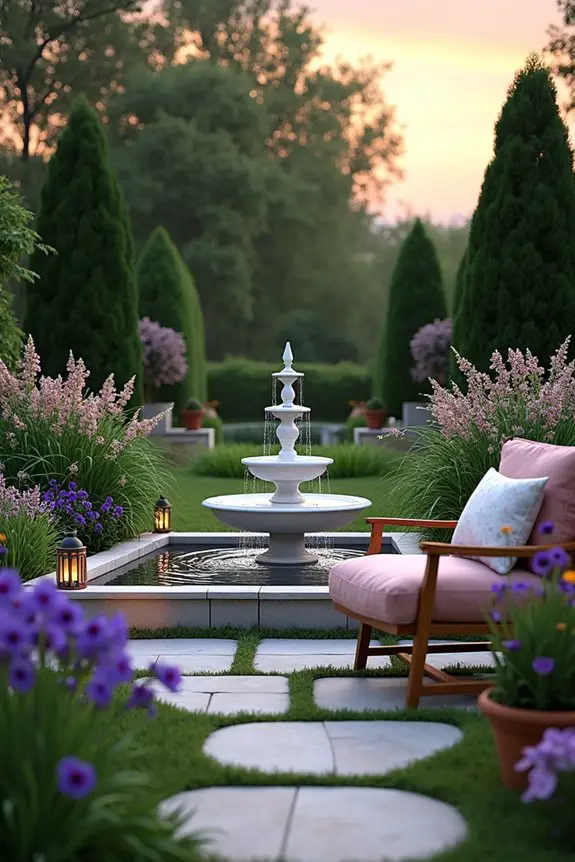
When it comes to adding a water feature to your garden, placement is everything. A well-placed fountain or pond doesn’t just look stunning; it creates a soothing atmosphere, turning your outdoor space into a serene escape. Imagine relaxing by the gentle sound of trickling water, the sunlight glistening on the surface, making it all feel like your own little paradise.
Start by considering the view. Place your water feature where you can easily admire it, maybe from your favorite cozy chair or while sipping your morning coffee. I once placed a small fountain too far back in my garden, and let’s just say—if I’d a dollar for every time I forgot it was there, I could buy another fountain.
Pro tip: a good location can transform a simple accent into the focal point of your garden.
Next, think about the plants surrounding it. Try adding some colorful flowers or leafy greens nearby. I made the rookie mistake of planting prickly cacti around mine, thinking it would look cool. Spoiler: it did not!
Opt for soft petals like irises or ferns that can frame your feature beautifully and soften the overall look. It also creates a lovely contrast, with the water shimmering and the colors popping. The blend sets a peaceful stage, making you want to linger a little longer. Installing T8 fluorescent grow lights can also enhance plant growth, creating a vibrant environment.
Also, don’t forget about lighting. A water feature can be magical in the evening if you use subtle LED lights or lanterns. Just imagine those twinkling lights reflecting off the water—it’s an instant mood booster. I once experimented with fairy lights, but I went a tad overboard, and it looked more like a disco party than a tranquil garden.
So, take it easy on the lighting, or you may find yourself hosting a rave.
Finally, consider the maintenance of your water feature. Placing it where it’s easy to access for cleaning or refilling is essential. My first fountain was tucked away and soon became a jungle of leaves and bugs. Trust me, the fewer obstacles between you and your garden maintenance, the better. Additionally, incorporating elements like a UV grow light sterilizer can help keep the surrounding plants healthy and vibrant.
With careful placement, your water feature can become a beloved centerpiece, drawing you outside and making your garden feel alive with beauty.
4. Vertical Garden Structures
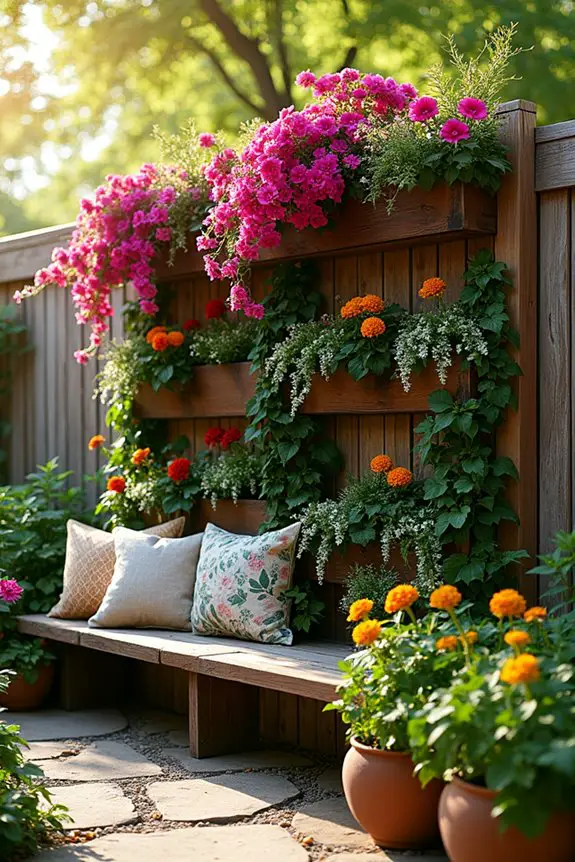
When it comes to creating a vertical garden, floral arrangements play a key role in merging functionality with style. Using vertical structures not only saves precious ground space but also adds height and dimension to your garden. It’s like doing double duty—growing beautiful blooms while maximizing what little yard space you may have.
Plus, a vertical garden can be a stunning focal point, drawing the eye upwards and creating a vibrant frame for your outdoor oasis.
One of the best ways to get started is by choosing a structure that suits your style. Whether you opt for a simple trellis, a wall planter, or a more elaborate hanging system, make certain it can support your plants without any hairy hiccups. Trellis planter boxes are an excellent option for combining beauty and practicality.
I once thought it would be fun to use an old wooden pallet as a vertical garden; let’s just say it didn’t exactly scream “elegance” but “rustic challenge” instead. Choose a sturdy, weather-resistant option and let your creativity soar.
Next up, let’s talk about plant selection. Aim for a mix of trailing plants and upright blooms to create visual interest. If you’re obsessed with the look of cascading blooms, try a sweet potato vine or petunias.
Just be cautious—if you plant too many different things, it might end up looking like a jumbled salad. Keep it cohesive; maybe stick to a color palette or a specific plant type to keep the vibe serene and chic.
Watering can also be a bit tricky with vertical arrangements, but fear not. Consider using drip irrigation or self-watering planters. These systems can save you time and keep your plants thriving without the hassle of climbing up a ladder every week. Additionally, using a portable hose reel cart can help keep your garden hose organized and easily accessible for watering needs.
I made the mistake of using regular pots at first, but they dried out quicker than my hopes for a rain-free weekend, leaving my plants looking rather sad.
Lastly, don’t forget to enjoy the process. Adding a vertical garden is a work in progress, and it allows you to express your personality fully. Start small, see what you love, and don’t sweat the little things—like the time I accidentally (but enthusiastically) mixed up my herbs and flowers.
Who knew cilantro and marigolds could cause such a scandal? Embrace the journey, and your vertical garden won’t only be functional; it will become a vibrant conversation piece that reflects your unique style.
5. Garden Lighting Ideas
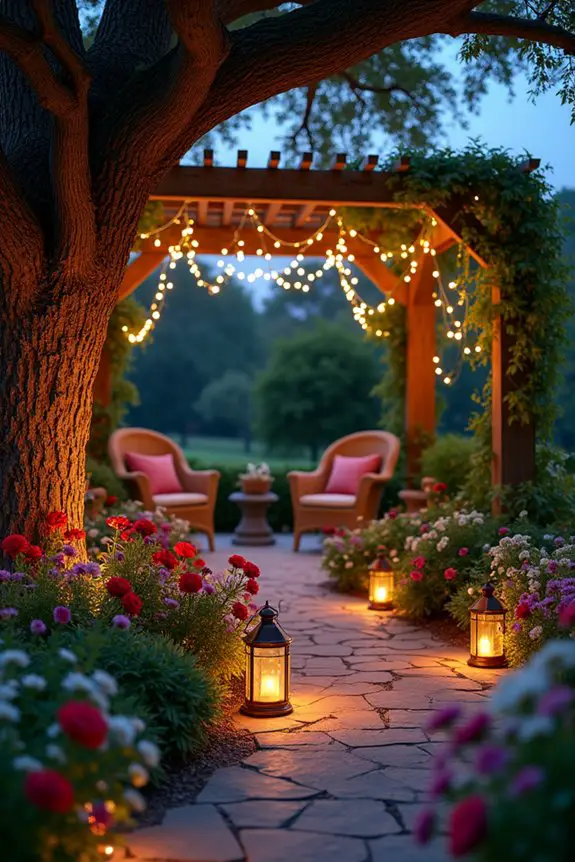
When it comes to lighting up your garden, the right illumination can transform your floral arrangements into a magical experience. A well-lit garden not only enhances the beauty of your blooms, making them pop against the night sky, but it also creates a cozy atmosphere that’s perfect for those evening get-togethers or quiet moments of reflection. Imagine sipping tea surrounded by flickering lights and sweet-smelling flowers; that’s the kind of vibe we’re going for.
Start by selecting the types of lights that speak to your style—think string lights for a whimsical touch, or lanterns for a more rustic, vintage feel. You can drape string lights around trees or fences, creating a dreamy canopy that makes even the most mundane flowers feel like star attractions. Just think, I hung some fairy lights once thinking I’d have an enchanted garden, but they ended up more “mildly amused fireflies.”
Choose a layout that best highlights your floral arrangements and your space’s overall charm.
Next, consider the placement. Position lights to highlight the focal points in your garden—like that gorgeous rose bush or your charming vertical garden. You want the light to “dance” around your plants, casting soft shadows and showcasing their colors without overwhelming them.
Just be careful not to go overboard. Once, I got a little too enthusiastic and turned my yard into what looked like a disco stage—cue the embarrassment of dancing with my pet hamster. Go for balance instead.
Don’t forget about solar lights; they’re low maintenance and environmentally friendly. They charge during the day and illuminate your garden at night, making them a fantastic choice if you’re anything like me—forgetting to plug things in is a specialty of mine.
Just try to place them in spots that get plenty of sunlight, or they’ll end up lighting up your path like the flicker of a dying candle, which, let’s be real, isn’t very enchanting.
Lastly, play with different lighting levels. Layer your lights to create depth—maybe mix some soft ground lights with fairy lights in trees for a fairy-tale effect. Don’t be afraid to experiment.
I may have blundered a bit when my cat decided to swing from the lights, but hey, every garden journey is filled with surprises. So, have fun with it, let your unique style shine, and watch your garden come to life as the sun sets, turning those simple floral arrangements into a mesmerizing display.
6. Garden Furniture Arrangement
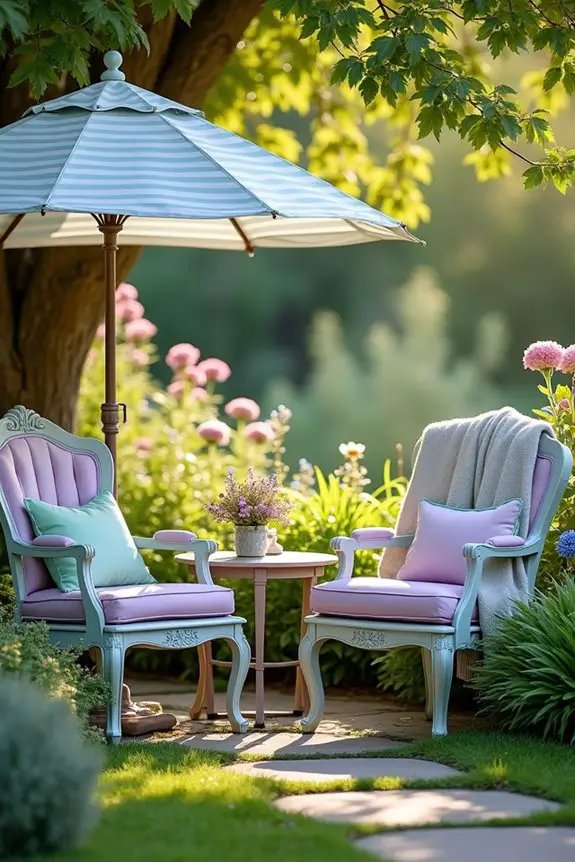
When it comes to arranging garden furniture, it’s all about creating a space that invites relaxation while showcasing your blooming beauties. Think about it: a cozy nook with comfortable seating lets you enjoy the lovely views and sweet scents of your flowers. Plus, a well-planned layout enhances the garden’s overall vibe, making it feel like a lovely extension of your home.
Start by determining the purpose of your furniture arrangement. Is it meant for leisurely afternoons spent with a good book, or lively gatherings with family and friends? I once thought I could cram a whole picnic table in my tiny garden corner, and let’s just say my guests experienced more of a “this is cozy” vibe than a “let’s spread out” one.
So, consider the size of your space and select furniture that fits well. Perhaps a couple of chairs and a small table, or a charming bench under your favorite tree could do the trick.
Next, think about where to place your furniture to create a flow. You want your seating to face the best views—maybe a vibrant flower bed or a stunning centerpiece. This positioning not only frames your floral arrangements beautifully but also attracts guests like a moth to a flame.
I once arranged my furniture facing a wall, and it felt more like a standoff than a gathering. Remember, the goal is to foster connection and conversation.
Also, consider using natural pathways to dictate your arrangement. For instance, if you already have stepping stones or a scenic path leading through your garden, align your seating along these paths. It’ll create an inviting natural flow, making it easy for guests to move around.
I found out the hard way that putting chairs too close together can create an awkward shuffle that rivals a clumsy dance-off, so keep that in mind.
Lastly, don’t forget to add personal touches. Throw in some colorful cushions that resonate with your garden colors or a small side table for drinks. Maybe even a whimsical umbrella for those hot sunny days—you know, to shield you from that “just one more sunburn” situation.
Personalizing your space makes it feel warm and inviting. I learned my lesson after a well-placed gnome had everyone talking more than the flowers, so don’t be afraid to show off your style.
With the right furniture arrangement, you’re not just decorating; you’re cultivating a lovely space for memories to blossom along with your floral arrangements. So grab a cup of coffee, sit back, and let your garden come alive.
7. Garden Border Designs
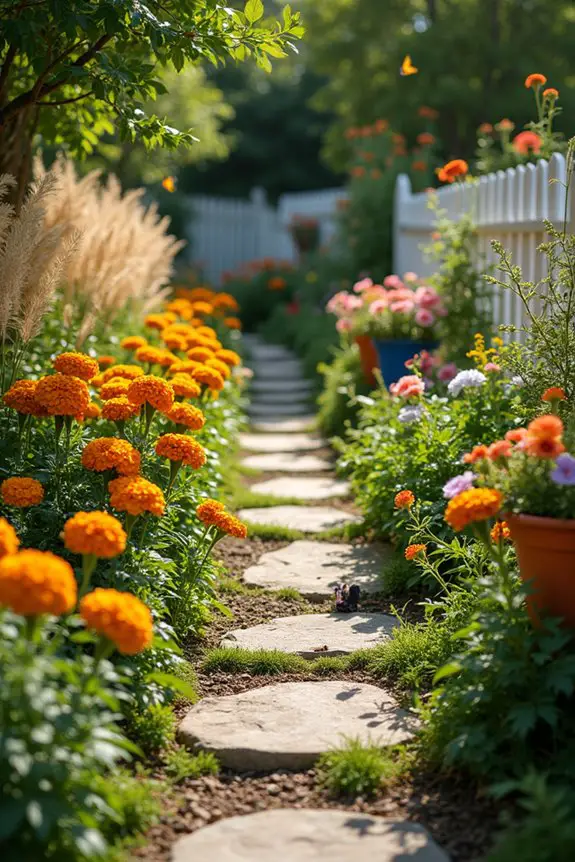
When it comes to framing your garden, borders can work wonders, both functionally and aesthetically. Think of borders as the picture frame around your floral masterpieces; they define the space and give your blooms a chance to shine. Whether you’re looking for a sophisticated edge or a whimsical touch, a well-designed border can elevate your garden’s style while also keeping those pesky weeds at bay.
Let’s explore a few ideas for garden borders that don’t just look great, but also serve a purpose. First, consider using a row of vibrant annuals or perennials as your border. Imagine a colorful array of marigolds or petunias lining the edge of your bed. Not only do they create a picturesque backdrop, but they can also help attract pollinators to your garden.
I once planted a row of sunflowers to brighten the border, giving my garden a sunny vibe that never fails to lift my spirits. Just be sure to space them correctly—no one wants a sunflower family reunion where they’re all squished together.
Another fantastic option is to use low-growing shrubs or ornamental grasses. Think about the texture and movement they can add to your garden. Grasses sway in the breeze and offer a relaxed aesthetic, while shrubs can provide structure.
I triple-failed when I tried to plant a climbing vine, only to realize it had ideas of its own and took over the entire fence. That’s when I discovered that low-maintenance plants can be your best friend. Plus, they keep things tidy, cutting down on garden chaos.
Hardscaping elements like bricks or stones can also serve as excellent borders. These sturdy features not only keep soil in place and create a defined walkway, but they can also add a touch of elegance. Picture a whimsical stone path leading to your vegetable patch—how inviting!
When I first lined my garden with stones, it felt like I’d rolled out the red carpet for my plants. Just remember to choose stones that blend with your space. No one wants their garden resembling a bulldozer’s playground.
Last but not least, don’t be shy about mixing materials or styles. Combining bricks with wood or incorporating a decorative fence can make your garden a unique reflection of your personality.
I once combined a picket fence with an array of colorful flower pots, and my garden was the talk of the neighborhood. It’s a fun way to express creativity while creating a unique visual flow throughout your space.
8. Themed Garden Room Concept
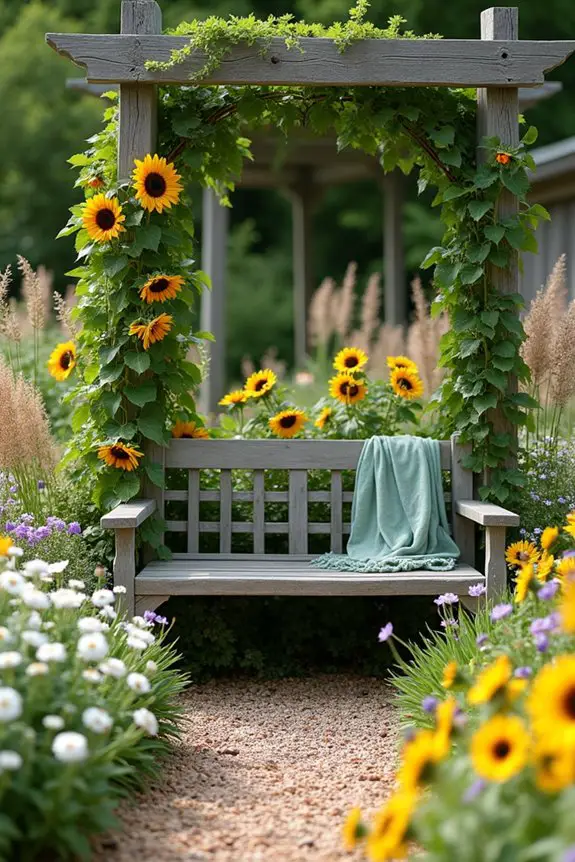
When it comes to creating a stunning garden, themed floral arrangements can truly take your design to the next level. Think of them as the soul of your garden; they can convey emotions, stories, or even memories. Plus, a well-thought-out theme can tie various elements of your outdoor space together, offering a cohesive vibe that’s both enchanting and inviting.
First up, let’s chat about color coordination. Choosing a color palette can make or break your floral arrangements. Go for a monochromatic scheme if you want an elegant look, perhaps shades of blue with white accents for a calming effect. On the other hand, a burst of complementary colors can evoke excitement, like reds and greens for a vibrant flair.
I once tried to mix every color of the rainbow—spoiler alert: it looked more like a toddler’s art project. Learning to edit your selections is essential.
Next, consider your theme. Is it rustic, tropical, or maybe cottagecore? Each theme calls for different flowers and foliage. For instance, sunflowers and daisies can bring that cheerful country feel, while orchids and palms can whisk you away to a tropical paradise.
Imagine walking through a garden filled with tall grasses and delicate wildflowers—pure bliss, right? I often get so carried away with themes that I end up planting a “medieval castle” garden complete with faux ivy vines; let’s just say it didn’t age well.
Also, balance is vital when arranging your blooms. Think about height, texture, and form. Mixing tall sunflowers with shorter, delicate pansies can create visual interest. And don’t forget about foliage. Adding some greenery can help frame your floral gems beautifully—it’s like putting the perfect spotlight on your stars.
I once left out the greens and my arrangement looked like a sad little bouquet fresh out of a drive-thru window.
Lastly, consider the time of year. Choosing seasonal flowers not only keeps your garden lively but also saves you from the dreaded frostbite scenario. Imagine planning a fall-themed garden bursting with red and orange mums while sipping on your pumpkin spice latte—now that’s a mood.
I learned this the hard way after planting summer blooms that got confused during an early freeze. Let’s just say, my garden looked more like a botanical graveyard than a summer paradise.
Creating themed floral arrangements isn’t just about pretty flowers; it’s about crafting an experience. So embrace the process, pick your palette, and let your personality shine through! Who knows, your garden could become the local haven everyone talks about—or at least a lovely escape after a stressful day.
9. Seasonal Plant Selection Strategy
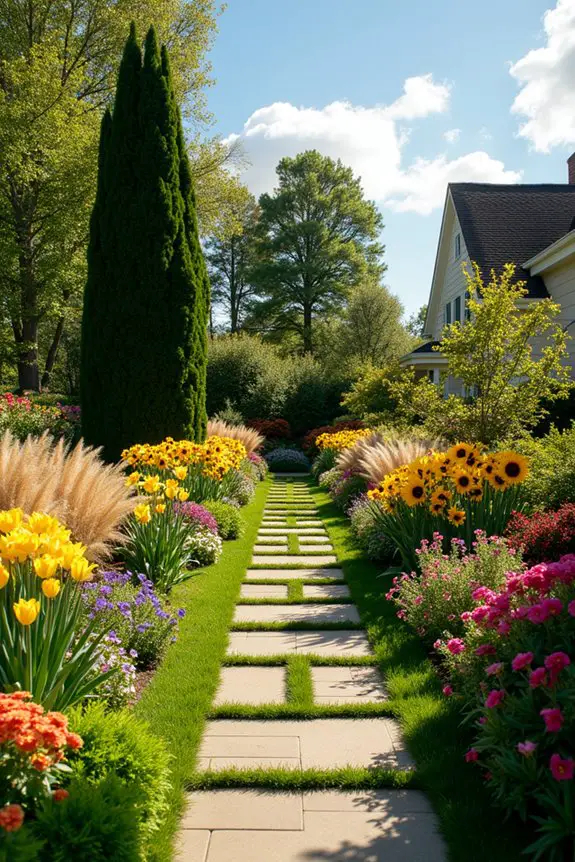
Selecting your plants based on the season isn’t just a clever strategy; it’s a game-changer for your garden’s health and beauty. Seasonal blooms thrive during their designated months, meaning you get vibrant colors and lively growth. Plus, a seasonal approach adds rhythmic charm to your garden, making it a delightful spot at different times of the year.
So, how do you engage with seasonal selections? Start by researching which plants bloom in your specific zone and during which months. For example, in spring, tulips and daffodils burst onto the scene, creating a spectacular show that’s practically a floral confetti party. Summer calls for vibrant sunflowers and petunias that can withstand the sun’s intensity. Fall brings us those enchanting crimson mums, perfect for that cozy autumn vibe.
I once tried to grow winter pansies in the heat of July—let’s just say they weren’t ready for the summer showdown and wilted faster than a bad performance on stage.
Next up, think about what you want to convey with your seasonal choices. Want to create a cheerful atmosphere? Opt for bright yellow and pink blooms in the spring and summer. If you’re aiming for a cozy, tranquil feel in autumn, rich oranges and deep reds can transform your garden into a peaceful retreat, as if you’re stepping into a warm cup of cider.
I attempted a hot pink and electric blue combination once in fall; I ended up with what looked like an unhinged rainbow threw up everywhere. Lesson learned—seasonal palettes matter.
Also, remember to incorporate perennials for stability. These resilient plants come back year after year, serving as the backbone of your design. Mix them with seasonal annuals for pops of color and changes throughout the year. I made the rookie mistake of solely planting annuals once.
Come winter, my garden looked like an abandoned playground—just bare soil and memories of brilliant blooms.
Don’t forget about maintenance too. Seasonal plants often need distinct care. Spring blooms might require regular watering, whereas some summer flowers thrive on neglect. Find out how much love each plant needs, so you’re not spending your weekends nurturing a garden that’s too demanding.
The last time I didn’t check, I ended up with a jungle of weeds as my main attraction—if that’s not a confidence booster, I don’t know what is.
Ultimately, mastering seasonal plant selection is the key to a flourishing and delightful garden that keeps surprising you. So roll up your sleeves, make your plant list, and get ready to meet your garden’s seasonal cast members!
10. Garden Layout Essentials
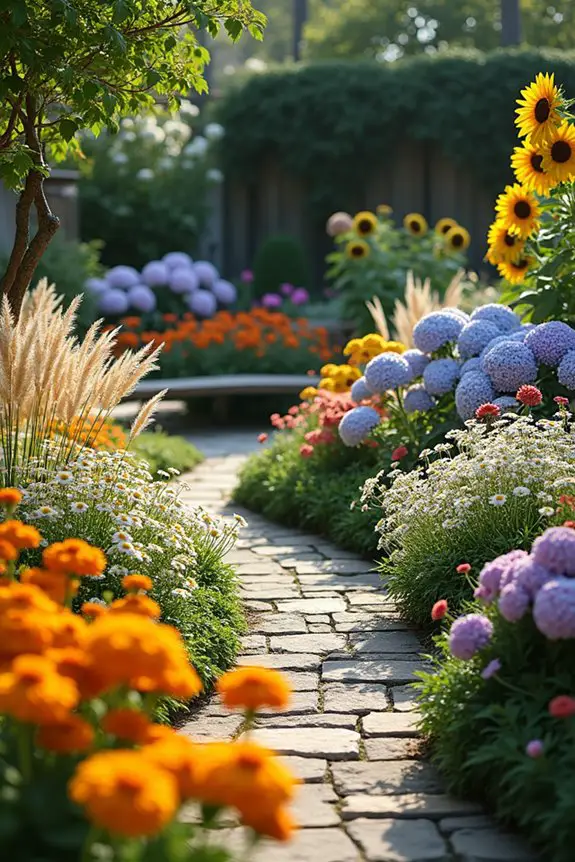
When it comes to arranging flowers, think of your garden as a beautiful symphony. Each bloom plays its own note, creating a harmonious overall vibe. A well-designed floral layout not only looks appealing but also guarantees that your plants thrive together, much like a perfectly timed dance routine—one that won’t end with someone stepping on toes.
Start by drafting your layout on paper, using grid lines to mimic how flowers will sit in your space. This little trick can save you from the dreaded “I should’ve planted those over there” moment later on.
When I first designed my garden, I didn’t sketch anything out. Let’s just say my layout turned into a chaotic flower wrestling match. I’d tall sunflowers standing awkwardly next to delicate daisies, creating a visual scene that was less “artsy garden” and more “what just happened here?”
Next, think about layering. Adding taller plants at the back and shorter ones in front creates depth. Imagine how stunning it’s to have a backdrop of cheerful sunflowers with vibrant marigolds dancing in the foreground. Their colors will pop against one another like old friends rekindling their love for each other at a reunion.
Choose plants with various heights and shapes and remember, variety adds excitement. Just be careful; I learned firsthand that putting all the funky, low-growing plants together can make it feel like a tiny garden rave gone wrong—too much chaos for comfort.
When choosing which varieties to mix, consider bloom time and color harmony. Pair contrasting colors, like blue hydrangeas next to yellow coreopsis, for visual interest, or stick with shades of the same color for a more serene vibe.
I once tried to make my purple and orange scheme work in my garden, thinking I’d created a masterpiece. Spoiler alert: it looked like a circus had a flower festival. Find your rhythm and avoid mixing shades that clash if you want that Pinterest-perfect garden.
Don’t forget to leave pathways and open spaces. Not only do they add functionality—because let’s be real, nobody wants to play leapfrog over flowers just to reach their favorite bench—but they also allow your plants room to breathe.
I, too, learned the hard way that cramming everything too close results in plants waging their own territorial wars. Instead, give your blooms some breathing room.
Lastly, embrace change. As plants grow and seasons change, your arrangements can evolve, too. A little creativity goes a long way.
I like to switch out annuals every season, if only as a way to convince myself my garden hasn’t become a sad, deserted landscape. Your floral arrangements should be a reflection of you—embrace the chaos, the lovely clash of colors, and the beauty in imperfection.
Watering Schedule Management
While it might seem trivial, managing your watering schedule can make or break your garden’s success. You don’t want to drown your plants or leave them parched, right?
Start by setting a routine. Water your lovely blooms early in the morning or late evening to prevent evaporation. Give those new sprouts a little extra TLC with daily watering for the first week; they’ll thank you later.
Consider installing a timer for consistency. Trust me, it beats trying to remember if you’ve watered today. And let’s face it, life in Bloxburg can get hectic.
Explore various bloxburg garden ideas for inspiration, but keep your schedule tight. With a little care and some laughs along the way, your garden will be thriving in no time.

